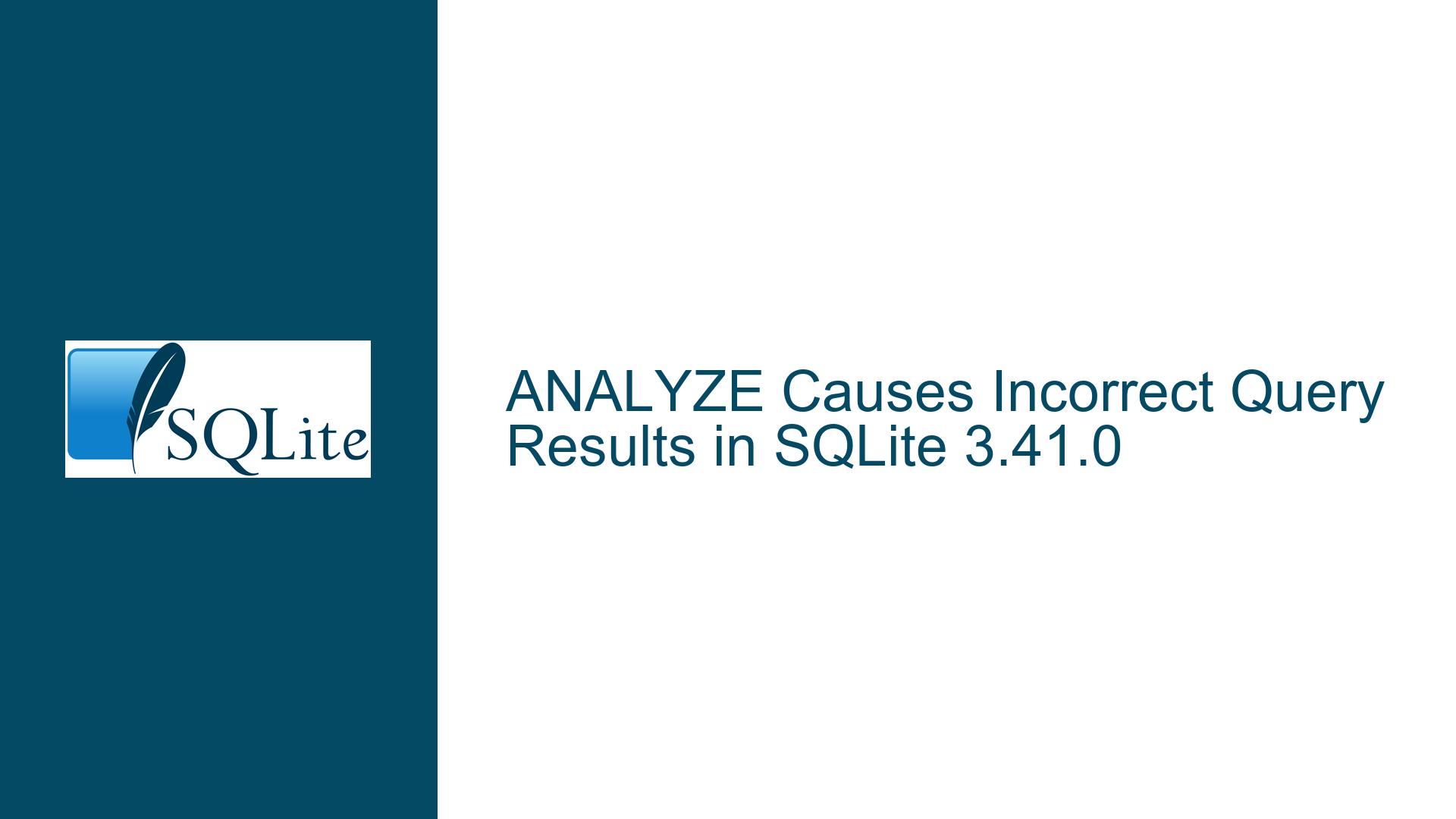ANALYZE Causes Incorrect Query Results in SQLite 3.41.0
Issue Overview: ANALYZE Impact on Query Results in SQLite
The core issue revolves around the ANALYZE command in SQLite version 3.41.0 causing discrepancies in query results. Specifically, when the ANALYZE command is executed, a SELECT query involving a NATURAL JOIN between two tables (t0 and t1) returns different results compared to when the ANALYZE command is omitted. This behavior is unexpected and indicates a potential bug in the query optimizer or the statistics collection mechanism of SQLite.
The schema involves two tables: t0 and t1. Both tables have a column c0 of type TEXT, and t1 has additional columns c1 (INTEGER) and c2 (TEXT). The query in question performs a NATURAL JOIN between t0 and t1 and filters rows where t1.c2 = t1.c0. The results of this query differ depending on whether ANALYZE has been run prior to the query execution.
In the first case, where ANALYZE is executed, the query returns an empty result set ({}). In the second case, where ANALYZE is omitted, the query returns a non-empty result set ({(),()}). This inconsistency suggests that the ANALYZE command is influencing the query planner in a way that leads to incorrect results.
Possible Causes: Why ANALYZE Affects Query Results
The ANALYZE command in SQLite is used to collect statistical information about the distribution of data in tables and indexes. This information is stored in the sqlite_stat1, sqlite_stat2, and sqlite_stat4 tables, which the query planner uses to make informed decisions about how to execute queries efficiently. The statistical data helps the planner choose the best indexes, join orders, and access methods.
In this scenario, the issue likely stems from one or more of the following causes:
Incorrect Statistics Collection: The
ANALYZEcommand may be collecting incorrect or incomplete statistics about the tables involved in the query. For example, it might misestimate the number of distinct values in a column or the distribution of values, leading the query planner to make suboptimal decisions.Query Planner Misinterpretation: The query planner might be misinterpreting the collected statistics, leading it to choose an incorrect execution plan. This could happen if the statistics suggest that a particular index or join order is more efficient when, in fact, it is not.
Index Interaction: The presence of an index on
t1(specifically,i43) might be influencing the query planner’s decisions in unexpected ways. The index is defined on a complex expression involvingc2, which could confuse the planner when combined with theNATURAL JOINand theWHEREclause.Data Type Mismatch: The query involves comparisons between columns of type
TEXT, but the data inserted into these columns includes a mix of text, numeric, and binary values. This could lead to unexpected behavior in the query planner, especially when combined with theANALYZEcommand.Bug in SQLite 3.41.0: The issue might be a bug in the specific version of SQLite (3.41.0) that affects how the
ANALYZEcommand interacts with the query planner. This is supported by the fact that the issue was reported and subsequently fixed in later versions.
Troubleshooting Steps, Solutions & Fixes: Addressing the ANALYZE-Induced Query Discrepancy
To resolve the issue of incorrect query results caused by the ANALYZE command, follow these detailed troubleshooting steps and solutions:
Verify SQLite Version: Ensure that you are using the latest stable version of SQLite. The issue was reported in version 3.41.0 and was fixed in later versions. Upgrading to a newer version (e.g., 3.41.1 or later) should resolve the problem.
Re-run ANALYZE: If upgrading is not immediately feasible, try re-running the
ANALYZEcommand to ensure that the statistics are collected correctly. Sometimes, re-analyzing the tables can correct any inaccuracies in the statistics.Inspect Statistics Tables: Manually inspect the contents of the
sqlite_stat1,sqlite_stat2, andsqlite_stat4tables to verify that the statistics are accurate. Look for any anomalies, such as incorrect row counts or skewed distributions, that might be causing the query planner to make incorrect decisions.Force Query Plan: Use the
EXPLAIN QUERY PLANstatement to examine the execution plan chosen by the query planner. Compare the plans generated with and without theANALYZEcommand to identify any differences. If necessary, use query hints or manual indexing to force the planner to use a specific execution plan.Simplify the Query: Break down the query into smaller parts to isolate the issue. For example, try running the
NATURAL JOINwithout theWHEREclause to see if the issue persists. This can help identify whether the problem lies in the join logic or the filtering condition.Check Data Types: Ensure that the data types of the columns involved in the query are consistent and appropriate for the comparisons being made. In this case, the columns
c0andc2are both of typeTEXT, but the data inserted includes numeric and binary values. Consider normalizing the data to avoid potential type mismatches.Review Index Definitions: Examine the definition of the index
i43ont1. The index is defined on a complex expression involvingc2, which might be causing issues with the query planner. Consider simplifying the index or removing it temporarily to see if it resolves the issue.Use Explicit Joins: Instead of using a
NATURAL JOIN, try rewriting the query using an explicitINNER JOINwith anONclause. This can provide more control over the join conditions and help avoid any ambiguities that might arise from theNATURAL JOIN.Test with Different Data Sets: Experiment with different data sets to see if the issue is specific to the current data or if it occurs more generally. This can help determine whether the problem is related to the data distribution or a more fundamental issue with the query planner.
Report the Issue: If the issue persists after trying the above steps, consider reporting it to the SQLite development team. Provide a detailed description of the problem, including the SQL statements, the expected results, and the actual results. This can help the developers identify and fix any underlying bugs.
By following these steps, you should be able to identify and resolve the issue of incorrect query results caused by the ANALYZE command in SQLite. The key is to systematically isolate the problem, verify the statistics and query plans, and ensure that the data and schema are consistent and appropriate for the queries being executed.






